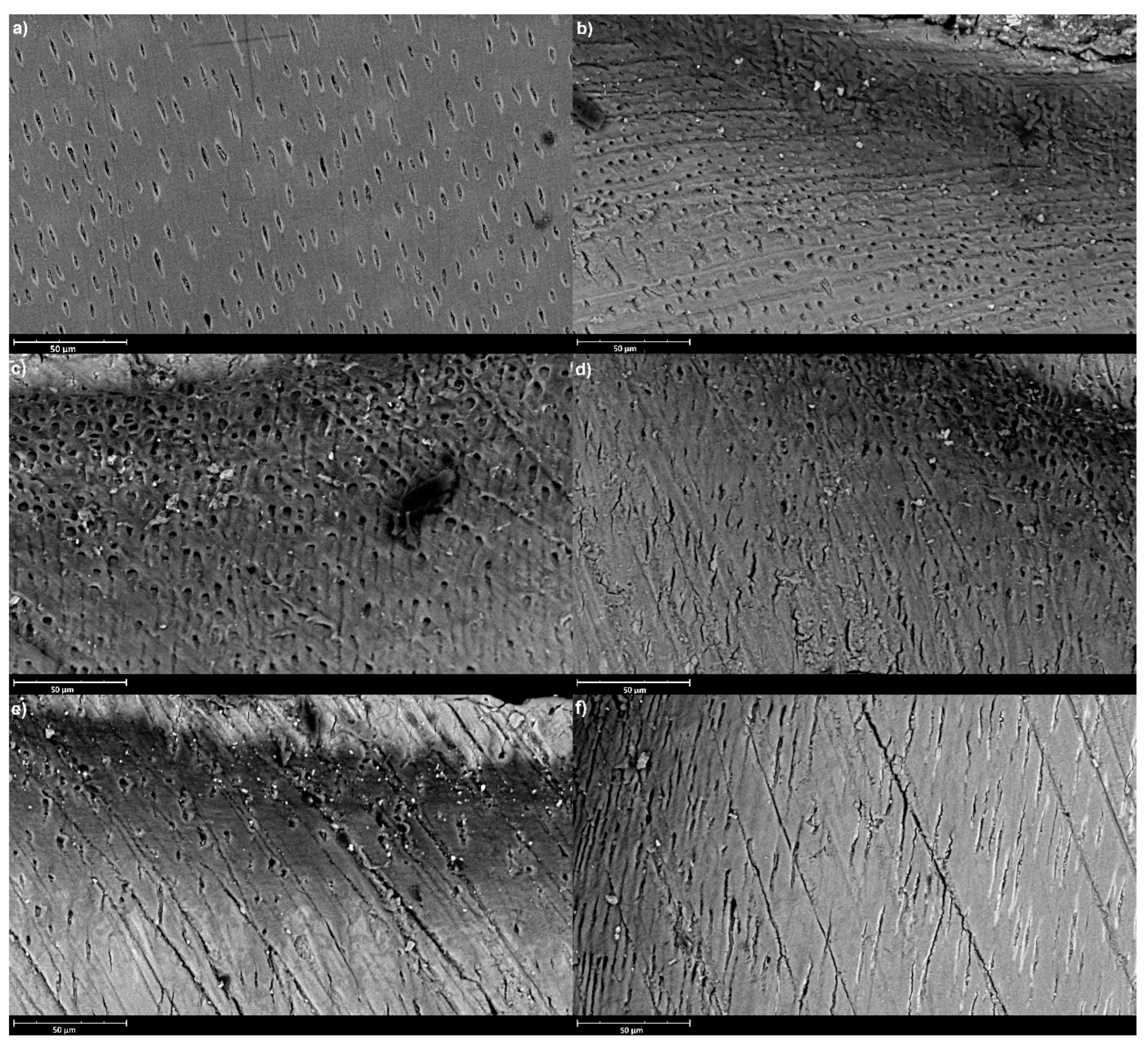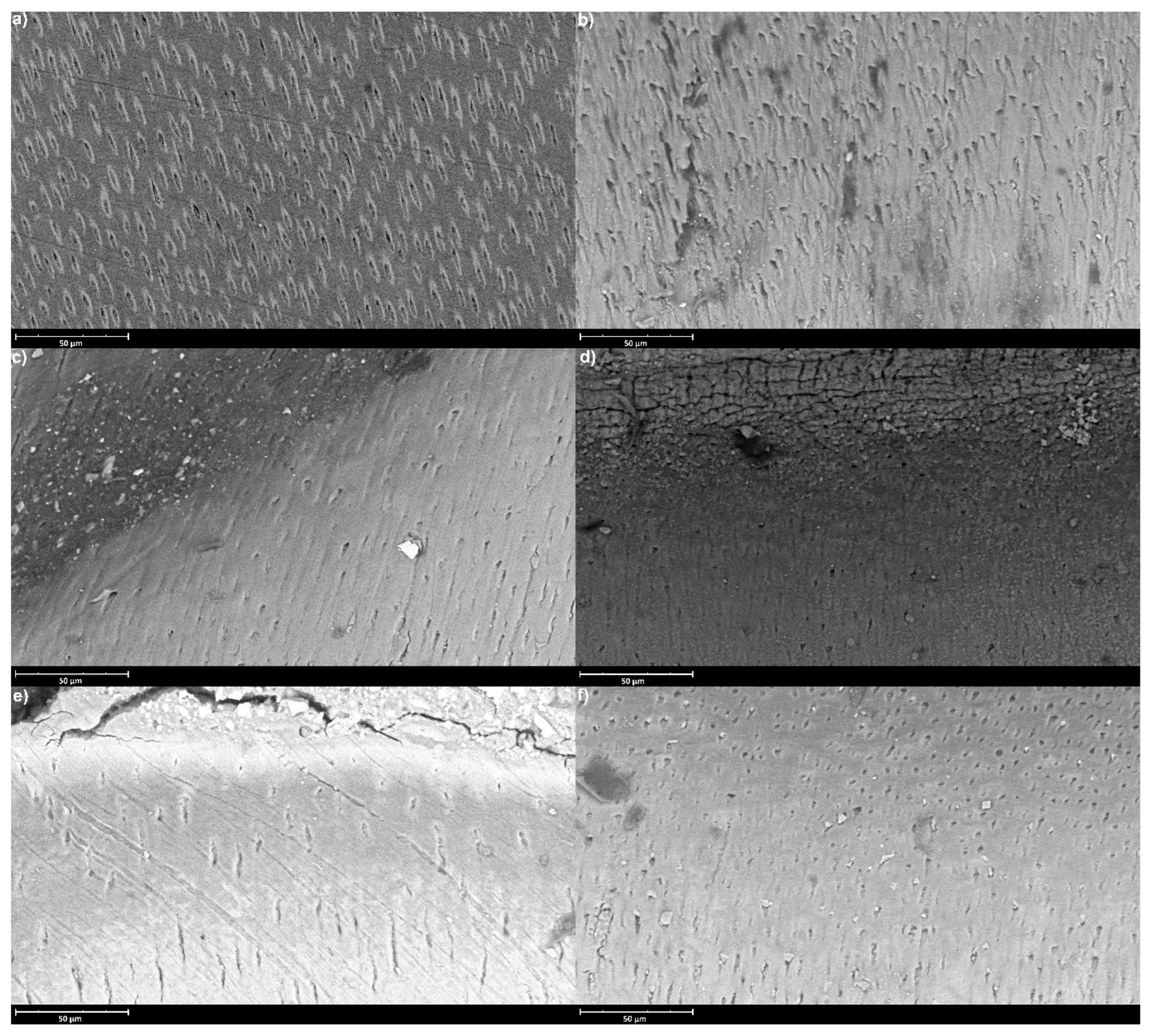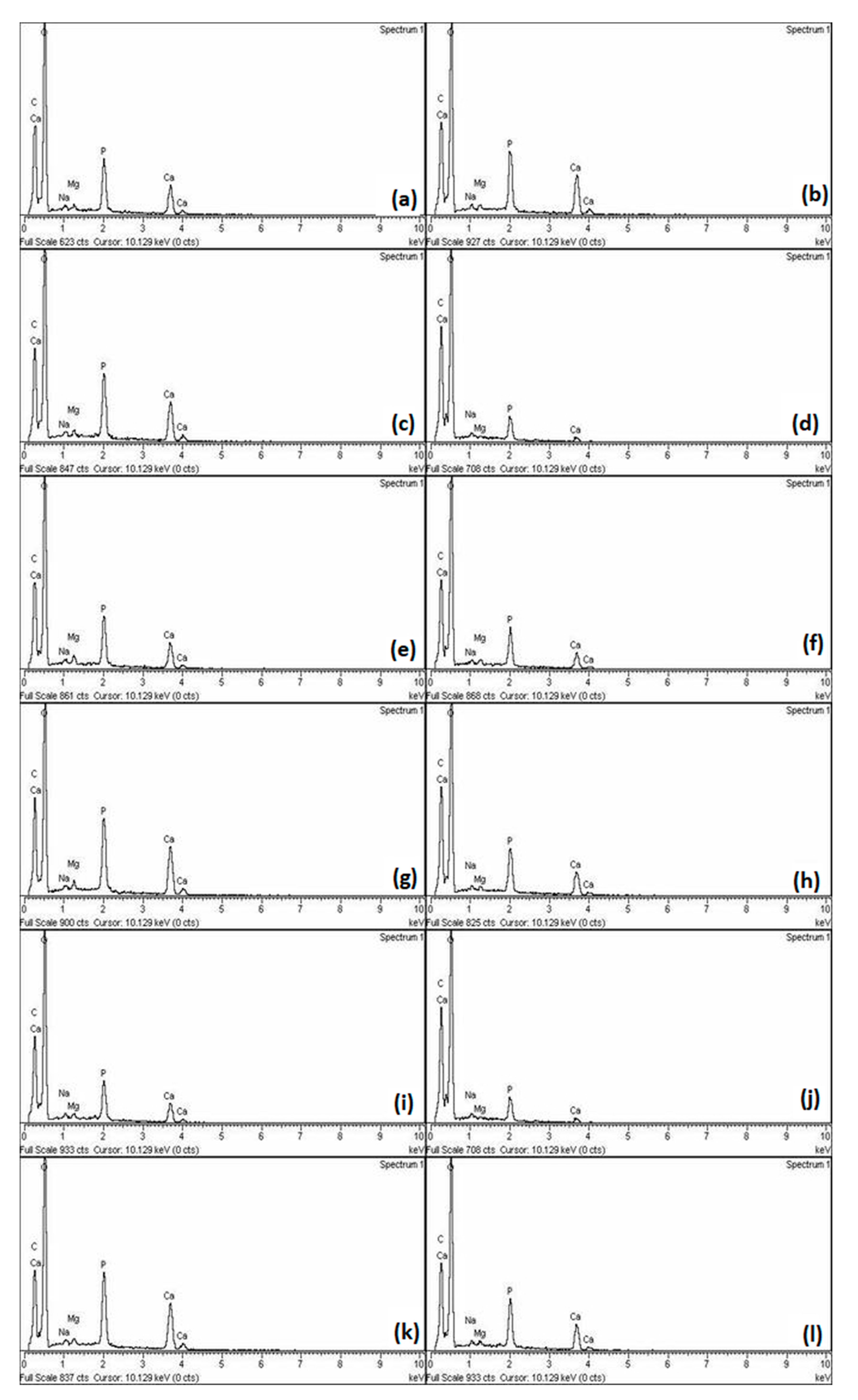Effects of Ion-Releasing Materials on Dentine: Analysis of Microhardness, Appearance, and Chemical Composition
Abstract
:1. Introduction
- There is no difference in dentine microhardness values among the tested materials.
- There are no differences in the mineral composition of the specimens treated with the tested materials.
- There are no differences in the micro-surface appearance between groups.
2. Materials and Methods
2.1. Sample Preparation
2.2. Vickers Microhardness Measurement
2.3. SEM Analysis
2.4. EDS Analysis
2.5. Statistical Analysis
3. Results
4. Discussion
5. Conclusions
Author Contributions
Funding
Institutional Review Board Statement
Informed Consent Statement
Data Availability Statement
Conflicts of Interest
References
- Goldberg, M.; Kulkarni, A.B.; Young, M.; Boskey, A. Dentin: Structure, composition and mineralization. Front. Biosci. 2011, 3, 711–735. [Google Scholar] [CrossRef]
- Tjäderhane, L.; Carrilho, M.R.; Breschi, L.; Tay, F.R.; Pashley, D.H. Overview of dentin structure. Endod. Top. 2009, 20, 3–29. [Google Scholar] [CrossRef]
- Niu, L.-N.; Zhang, W.; Pashley, D.H.; Breschi, L.; Mao, J.; Chen, J.-H.; Tay, F.R. Biomimetic remineralization of dentin. Dent. Mater. 2014, 30, 77–96. [Google Scholar] [CrossRef]
- Bertassoni, L.E.; Habelitz, S.; Kinney, J.H.; Marshall, S.J.; Marshall, G.W., Jr. Biomechanical Perspective on the Remineralization of Dentin. Caries Res. 2009, 43, 70–77. [Google Scholar] [CrossRef] [PubMed]
- Sauro, S.; Osorio, R.; Watson, T.F.; Toledano, M. Influence of phosphoproteins’ biomimetic analogs on remineralization of mineral-depleted resin–dentin interfaces created with ion-releasing resin-based systems. Dent. Mater. 2015, 31, 759–777. [Google Scholar] [CrossRef] [PubMed]
- Pires, P.M.; Neves, A.D.A.; Makeeva, I.M.; Schwendicke, F.; Faus-Matoses, V.; Yoshihara, K.; Banerjee, A.; Sauro, S. Contemporary restorative ion-releasing materials: Current status, interfacial properties and operative approaches. Br. Dent. J. 2020, 229, 450–458. [Google Scholar] [CrossRef]
- Christensen, G.J. The advantages of minimally invasive dentistry. J. Am. Dent. Assoc. 2005, 136, 1563–1565. [Google Scholar] [CrossRef]
- Mirsiaghi, F.; Leung, A.; Fine, P.; Blizard, R.; Louca, C. An investigation of general dental practitioners’ understanding and perceptions of minimally invasive dentistry. Br. Dent. J. 2018, 225, 420–424. [Google Scholar] [CrossRef]
- Brambilla, E.; Ionescu, A.C. Oral Biofilms and Secondary Caries Formation. In Oral Biofilms and Modern Dental Materials: Ad-vances toward Bioactivity; Springer Nature: Basingstoke, UK, 2021; pp. 19–35. [Google Scholar]
- Nicholson, J.W. Chemistry of glass-ionomer cements: A review. Biomaterials 1998, 19, 485–494. [Google Scholar] [CrossRef]
- Menezes-Silva, R.; Cabral, R.N.; Pascotto, R.C.; Borges, A.F.S.; Martins, C.C.; de Lima Navarro, M.F.; Sidhu, S.K.; Leal, S.C. Mechanical and optical properties of conventional restorative glass-ionomer cements—A systematic review. J. Appl. Oral Sci. 2019, 27, e2018357. [Google Scholar] [CrossRef]
- Cho, S.Y.; Cheng, A.C. A review of glass ionomer restorations in the primary dentition. J. Can. Dent. Assoc. 1999, 65, 491–495. [Google Scholar] [PubMed]
- Sidhu, S.K.; Nicholson, J.W. A Review of Glass-Ionomer Cements for Clinical Dentistry. J. Funct. Biomater. 2016, 7, 16. [Google Scholar] [CrossRef] [PubMed]
- Hasan, A.M.H.R.; Sidhu, S.K.; Nicholson, J.W. Fluoride release and uptake in enhanced bioactivity glass ionomer cement (“glass carbomer™”) compared with conventional and resin-modified glass ionomer cements. J. Appl. Oral Sci. 2019, 27, e20180230. [Google Scholar] [CrossRef] [PubMed]
- Barot, T.; Rawtani, D.; Kulkarni, P. Nanotechnology-based materials as emerging trends for dental applications. Rev. Adv. Mater. Sci. 2021, 60, 173–189. [Google Scholar] [CrossRef]
- Kutuk, Z.; Ozturk, C.; Cakir, F.; Gurgan, S. Mechanical performance of a newly developed glass hybrid restorative in the restoration of large MO Class 2 cavities. Niger. J. Clin. Pract. 2019, 22, 833–841. [Google Scholar] [CrossRef]
- Torabinejad, M.; Hong, C.; McDonald, F.; Pitt Ford, T.R. Physical and chemical properties of a new root-end filling material. J. Endod. 1995, 21, 349–353. [Google Scholar] [CrossRef]
- Shetty, S.; Bhat, R.; Kini, A.; Shetty, P. Microleakage Evaluation of an Alkasite Restorative Material: An In Vitro Dye Penetration Study. J. Contemp. Dent. Pract. 2019, 20, 1315–1318. [Google Scholar] [CrossRef]
- Bertassoni, L.E.; Habelitz, S.; Marshall, S.J.; Marshall, G.W. Mechanical recovery of dentin following remineralization in vitro—An indentation study. J. Biomech. 2011, 44, 176–181. [Google Scholar] [CrossRef]
- Braga, R.R.; Habelitz, S. Current Developments on Enamel and Dentin Remineralization. Curr. Oral Health Rep. 2019, 6, 257–263. [Google Scholar] [CrossRef]
- Bahammam, S.; Nathanson, D.; Fan, Y. Evaluating the Mechanical Properties of Restorative Glass Ionomers Cements. Int. Dent. J. 2022, 72, 859–865. [Google Scholar] [CrossRef]
- Cate, J.M.T.; Damen, J.; Buijs, M. Inhibition of Dentin Demineralization by Fluoride in vitro. Caries Res. 1998, 32, 141–147. [Google Scholar] [CrossRef]
- Tschoppe, P.; Meyer-Lueckel, H.; Kielbassa, A. Effect of carboxymethylcellulose-based saliva substitutes on predemineralised dentin evaluated by microradiography. Arch. Oral Biol. 2008, 53, 250–256. [Google Scholar] [CrossRef] [PubMed]
- Schwendicke, F.; Al-Abdi, A.; Moscardó, A.P.; Cascales, A.F.; Sauro, S. Remineralization effects of conventional and experimental ion-releasing materials in chemically or bacterially-induced dentin caries lesions. Dent. Mater. 2019, 35, 772–779. [Google Scholar] [CrossRef] [PubMed]
- Ngo, H.C.; Mount, G.; Mc Intyre, J.; Tuisuva, J.; Von Doussa, R. Chemical exchange between glass-ionomer restorations and residual carious dentine in permanent molars: An in vivo study. J. Dent. 2006, 34, 608–613. [Google Scholar] [CrossRef] [PubMed]
- Ten Cate, J.M.; Buus, J.M.; Damen, J.M. The effects of GIC restorations on enamel and dentin demineralization and remineralization. Adv. Dent. Res. 1995, 9, 384–388. [Google Scholar] [CrossRef]
- Bueno, L.S.; Silva, R.M.; Magalhães, A.P.R.; Navarro, M.F.L.; Pascotto, R.C.; Buzalaf, M.A.; Nicholson, J.W.; Sidhu, S.K.; Borges, A.F.S. Positive correlation between fluoride release and acid erosion of restorative glass-ionomer cements. Dent. Mater. 2019, 35, 135–143. [Google Scholar] [CrossRef] [PubMed]
- De Moor, R.J.; Verbeeck, R.M.; De Maeyer, E.A. Fluoride release profiles of restorative glass ionomer formulations. Dent. Mater. 1996, 12, 88–95. [Google Scholar] [CrossRef]
- Griffin, S.; Hill, R. Influence of glass composition on the properties of glass polyalkenoate cements. Part IV: Influence of fluorine content. Biomaterials 2000, 21, 693–698. [Google Scholar] [CrossRef]
- Luo, Z.; Li, D.; Kohli, M.R.; Yu, Q.; Kim, S.; He, W.-X. Effect of Biodentine™ on the proliferation, migration and adhesion of human dental pulp stem cells. J. Dent. 2014, 42, 490–497. [Google Scholar] [CrossRef]
- Al-Abdi, A.; Paris, S.; Schwendicke, F. Glass hybrid, but not calcium hydroxide, remineralized artificial residual caries lesions in vitro. Clin. Oral Investig. 2016, 21, 389–396. [Google Scholar] [CrossRef]
- Laurent, P.; Camps, J.; About, I. BiodentineTM induces TGF-β1 release from human pulp cells and early dental pulp mineralization. Int. Endod. J. 2011, 45, 439–448. [Google Scholar] [CrossRef]
- Panpisut, P.; Toneluck, A. Monomer conversion, dimensional stability, biaxial flexural strength, and fluoride release of resin-based restorative material containing alkaline fillers. Dent. Mater. J. 2020, 39, 608–615. [Google Scholar] [CrossRef]
- Theerarath, T.; Sriarj, W. An alkasite restorative material effectively remineralized artificial interproximal enamel caries in vitro. Clin. Oral Investig. 2022, 26, 4437–4445. [Google Scholar] [CrossRef]
- Donly, K.J.; Liu, J.A. Dentin and enamel demineralization inhibition at restoration margins of Vitremer, Z 100 and Cention N. Am. J. Dent. 2018, 31, 166–168. [Google Scholar]
- Shaik, Z.A.; Rambabu, T.; Sajjan, G.; Varma, M.; Satish, K.; Raju, V.B.; Ganguru, S.; Ventrapati, N. Quantitative Analysis of Remineralization of Artificial Carious Lesions with Commercially Available Newer Remineralizing Agents Using SEM-EDX- In Vitro Study”. J. Clin. Diagn. Res. 2017, 11, ZC20–ZC23. [Google Scholar] [CrossRef]
- Mousavinasab, S.M.; Meyers, I. Fluoride Release by Glass Ionomer Cements, Compomer and Giomer. Dent. Res. J. 2009, 6, 75–81. [Google Scholar]
- Almahdy, A.; Downey, F.; Sauro, S.; Cook, R.; Sherriff, M.; Richards, D.; Watson, T.; Banerjee, A.; Festy, F. Microbiochemical Analysis of Carious Dentine Using Raman and Fluorescence Spectroscopy. Caries Res. 2012, 46, 432–440. [Google Scholar] [CrossRef] [PubMed]
- Salinovic, I.; Schauperl, Z.; Marcius, M.; Miletic, I. The Effects of Three Remineralizing Agents on the Microhardness and Chemical Composition of Demineralized Enamel. Materials 2021, 14, 6051. [Google Scholar] [CrossRef] [PubMed]
- Angker, L.; Nockolds, C.; Swain, M.V.; Kilpatrick, N. Correlating the mechanical properties to the mineral content of carious dentine—A comparative study using an ultra-micro indentation system (UMIS) and SEM-BSE signals. Arch. Oral Biol. 2004, 49, 369–378. [Google Scholar] [CrossRef] [PubMed]
- Shetty, S.; Hegde, M.; Bopanna, T. Enamel remineralization assessment after treatment with three different remineralizing agents using surface microhardness: An in vitro study. J. Conserv. Dent. 2014, 17, 49–52. [Google Scholar] [CrossRef]
- Joshi, C.; Gohil, U.; Parekh, V.; Joshi, S. Comparative evaluation of the remineralizing potential of commercially available agents on artificially demineralized human enamel: An In vitro study. Contemp. Clin. Dent. 2019, 10, 605–613. [Google Scholar] [CrossRef]
- Damato, F.; Strang, R.; Stephen, K. Effect of Fluoride Concentration on Remineralization of Carious Enamel an in vitro pH-Cycling Study. Caries Res. 1990, 24, 174–180. [Google Scholar] [CrossRef]
- Marsh, P.D. Microbiologic aspects of dental plaque and dental caries. Dent. Clin. N. Am. 1999, 43, 599–614. [Google Scholar] [CrossRef] [PubMed]
- Talwar, M.; Borzabadi-Farahani, A.; Lynch, E.; Borsboom, P.; Ruben, J. Remineralization of Demineralized Enamel and Dentine Using 3 Dentifrices—An InVitro Study. Dent. J. 2019, 7, 91. [Google Scholar] [CrossRef] [PubMed]
- Rajić, V.B.; Miletić, I.; Gurgan, S.; Peroš, K.; Verzak, Ž.; Malčić, A.I. Fluoride Release from Glass Ionomer with Nano Filled Coat and Varnish. Acta Stomatol. Croat. 2018, 52, 307–313. [Google Scholar] [CrossRef] [PubMed]
- Galler, K.M.; Weber, M.; Korkmaz, Y.; Widbiller, M.; Feuerer, M. Inflammatory Response Mechanisms of the Dentine–Pulp Complex and the Periapical Tissues. Int. J. Mol. Sci. 2021, 22, 1480. [Google Scholar] [CrossRef] [PubMed]
- Nyvad, B.; Machiulskiene, V.; Baelum, V. Reliability of a New Caries Diagnostic System Differentiating between Active and Inactive Caries Lesions. Caries Res. 1999, 33, 252–260. [Google Scholar] [CrossRef]
- Slimani, A.; Sauro, S.; Hernández, P.G.; Gurgan, S.; Turkun, L.S.; Miletic, I.; Banerjee, A.; Tassery, H. Commercially Available Ion-Releasing Dental Materials and Cavitated Carious Lesions: Clinical Treatment Options. Materials 2021, 14, 6272. [Google Scholar] [CrossRef]



| Material | Type | Manufacturer |
|---|---|---|
| EQUIA Forte® HT | Glass hybrid | GC Corporation, Tokyo, Japan |
| Riva Self Cure | Glass hybrid/glass ionomer cement [21] | SDI Limited, Melbourne, VI, Australia |
| Cention Forte | Alkasite | Ivoclar Vivadent AG, Schaan, Liechenstein |
| Biodentine™ | Tricalcium silicate-based material | SEPTODONT, Saint-Maur-des-fossés Cedex, France |
| GC Fuji TRIAGE® | Glass ionomer cement | GC Corporation, Tokyo, Japan |
| Material | After 14 Days | After 28 Days |
|---|---|---|
| EQUIA Forte® HT | 26.7 ± 1.45 | 37.74 ± 1.56 |
| Riva Self Cure | 19.66 ± 1.02 | 29.58 ± 1.18 |
| Cention Forte | 19.01 ± 1.24 | 27.93 ± 1.33 |
| Biodentine™ | 23.35 ± 1.23 | 29.92 ± 1.02 |
| GC Fuji TRIAGE® | 25.94 ± 1.35 | 33.87 ± 5.57 |
| Control Group | 15.57 ± 0.68 | 15.64 ± 0.82 |
Disclaimer/Publisher’s Note: The statements, opinions and data contained in all publications are solely those of the individual author(s) and contributor(s) and not of MDPI and/or the editor(s). MDPI and/or the editor(s) disclaim responsibility for any injury to people or property resulting from any ideas, methods, instructions or products referred to in the content. |
© 2023 by the authors. Licensee MDPI, Basel, Switzerland. This article is an open access article distributed under the terms and conditions of the Creative Commons Attribution (CC BY) license (https://creativecommons.org/licenses/by/4.0/).
Share and Cite
Šalinović, I.; Schwendicke, F.; Askar, H.; Yassine, J.; Miletić, I. Effects of Ion-Releasing Materials on Dentine: Analysis of Microhardness, Appearance, and Chemical Composition. Materials 2023, 16, 7310. https://doi.org/10.3390/ma16237310
Šalinović I, Schwendicke F, Askar H, Yassine J, Miletić I. Effects of Ion-Releasing Materials on Dentine: Analysis of Microhardness, Appearance, and Chemical Composition. Materials. 2023; 16(23):7310. https://doi.org/10.3390/ma16237310
Chicago/Turabian StyleŠalinović, Ivan, Falk Schwendicke, Haitham Askar, Jamila Yassine, and Ivana Miletić. 2023. "Effects of Ion-Releasing Materials on Dentine: Analysis of Microhardness, Appearance, and Chemical Composition" Materials 16, no. 23: 7310. https://doi.org/10.3390/ma16237310
APA StyleŠalinović, I., Schwendicke, F., Askar, H., Yassine, J., & Miletić, I. (2023). Effects of Ion-Releasing Materials on Dentine: Analysis of Microhardness, Appearance, and Chemical Composition. Materials, 16(23), 7310. https://doi.org/10.3390/ma16237310








